Stop thinking about adding vintage to your store’s collection and start shopping for a stellar assortment now. Where to begin? This article is a great place to start.
Photography by Kenji Toma
Prop styling by Eriko Nagata
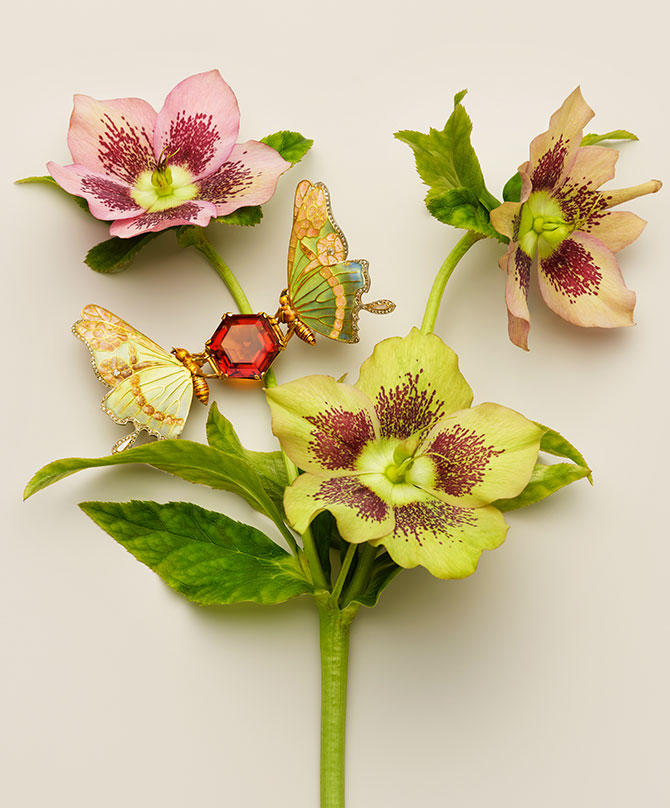 Circa 1900 French Art Nouveau 18k gold and enamel brooch with 36 ct. hexagonal-cut topaz and 1.3 cts. t.w. rose- and Old European–cut diamonds; $100,000; Macklowe Gallery; 212-644-6400; macklowegallery.com
Circa 1900 French Art Nouveau 18k gold and enamel brooch with 36 ct. hexagonal-cut topaz and 1.3 cts. t.w. rose- and Old European–cut diamonds; $100,000; Macklowe Gallery; 212-644-6400; macklowegallery.com
No doubt about it: vintage jewels are hugely in vogue, making it the perfect time to add an estate jewelry capsule to your store’s offerings. Whether you’re dipping a toe in for the first time or looking to grow your current business, these pro tips will set you up for success.
Buy “Over the Counter”
Successful estate jewelers acquire their inventory from a number of sources, including local and online auctions, flea markets, and, at the highest level, from professional dealers at antiques fairs. That said, you get the best bargains when you purchase directly from the consumer.
Lee Siegelson, a New York City–based dealer of museum-quality antique jewels, looks to acquire “the absolute best examples, wherever I find them,” he says. “Of course, it’s preferable to develop a relationship with a family and purchase a piece that has never been seen on the market before.”
Consider contacting local attorneys who handle estates for some leads. You can also let your customers know that you’re in the market for their heirloom jewelry. How to do this tastefully? “We recently did a few radio ads for an antique trunk show at our store and mentioned that we’re open to buying, which brought in a few interesting pieces,” says Steve Quick, owner of Steve Quick Jeweler in Chicago.
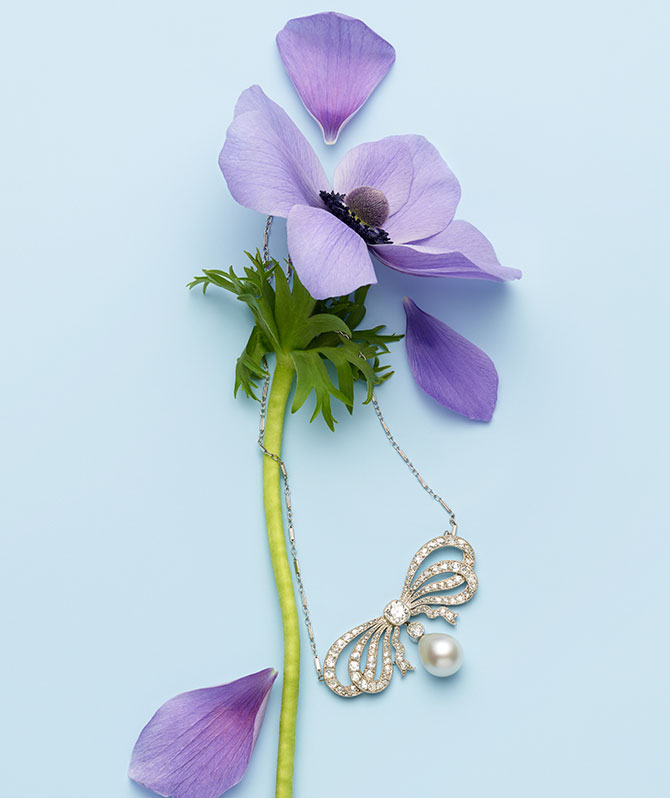 Edwardian necklace with a 1 ct. diamond, 3.1 cts. t.w. accent diamonds, and a
Edwardian necklace with a 1 ct. diamond, 3.1 cts. t.w. accent diamonds, and a
12.55 mm pearl drop; $12,500; Provident Jewelry; 561-747-4449; providentjewelry.com
Stock the Most Popular Eras
When curating a vintage collection, stay focused on the eras that are trending. JCK has confirmed that Art Deco and Victorian jewels continue to be hot. “The trendsetters on Instagram are loving anything Georgian, mourning jewelry, and rose-cut diamonds,” says Diane Richardson, owner of the Gold Hatpin in the Chicago area. “I consistently sell more rings than anything else. And charms—all kinds of interesting little hanging fobs, padlocks, figas, and talismans—sell well.”
Staple pieces, like Art Deco and Edwardian engagement rings and platinum or white gold filigree jewelry, are always popular, as are designs from the 1960s and ’70s, particularly those signed by Cartier and Van Cleef & Arpels. “Really, anything mid–20th century on is popular and wearable,” says Debbi Wilson, owner of Vendome Collection in San Antonio. “A Cartier long pendant necklace from the ’70s or an Angela Cummings inlaid bangle from the ’80s are nice and can be thought of as casual or dressy.”
The savviest estate and vintage jewelry sellers always curate with an eye for unique, one-of-a-kind designs—say, a hammered silver cape clasp by Alexander Calder or a Bakelite suite by artist Daniel Brush. “The authentic and rare will always be highest in demand—that’s the name of the game,” says Mia Moross, owner of The One I Love NYC.
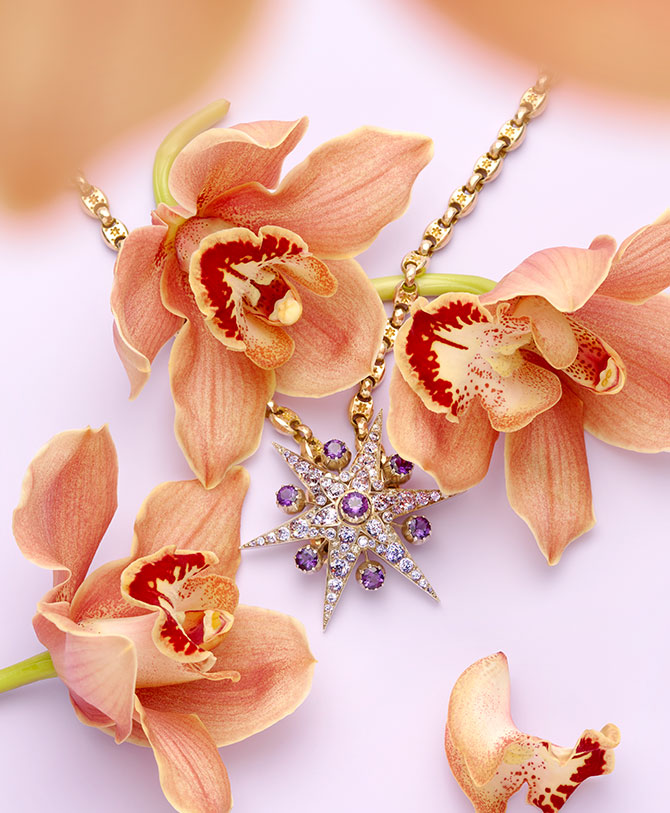 Victorian star Iris necklace with 6 cts. t.w. diamonds and 5 cts. t.w. amethysts on 100-inch antique gold chain; $75,000; Toni + Chloë Goutal; chloegoutal@gmail.com; toniandchloegoutal.com
Victorian star Iris necklace with 6 cts. t.w. diamonds and 5 cts. t.w. amethysts on 100-inch antique gold chain; $75,000; Toni + Chloë Goutal; chloegoutal@gmail.com; toniandchloegoutal.com
Research Periods and Prices
The success of your vintage jewelry business requires conducting abundant research about the eras you’re carrying—at a minimum, the dates, the design hallmarks and distinctions, as well as the definitive makers. You’ll need to appear knowledgeable and authoritative to customers who are often eager to acquire this knowledge themselves. Your command of this information will also help customers understand the rarity of an item and how this affects the price.
Speaking of price, these days customers can learn a lot about the history of a given piece online, so be sure to do your own homework. “It’s harder for a dealer to argue with an educated customer,” says vintage jewelry dealer Robin Katz, who sells to the trade and to the public. “It’s a good idea to Google a piece before purchasing in case it’s been in a recent auction,” she adds. “The exposure a piece receives while in an auction may affect a retailer’s ability to resell that piece and what they can charge for it. You may be quoted a more favorable price, whether it’s sold or not.”
Likewise, the more informed you are about antique jewelry, the less likely you are to fall victim to shady deals. Many jewelers report interactions with vendors who pass off reproductions as genuine antiques. Whether they do so knowingly or unknowingly, arming yourself with information makes you much less vulnerable. At trade shows, try to network with pros who know more than you. Most are generous with their expertise, and once you establish a relationship, you can refer business to each other as needed.
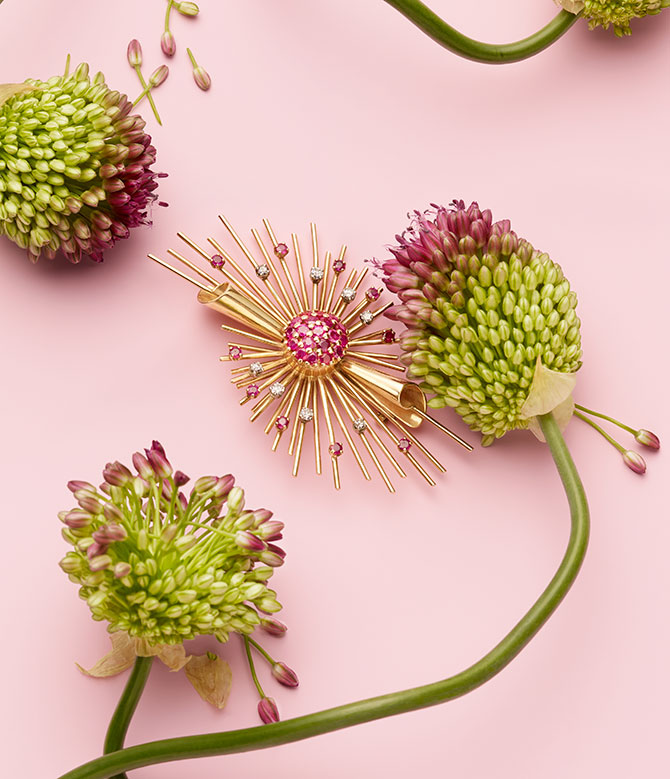 14k yellow gold pin with 0.8 ct. t.w. rubies and 0.72 ct. t.w. diamonds, circa 1940s; $2,495; The Gold Hatpin; 708-445-0610; goldhatpin.com
14k yellow gold pin with 0.8 ct. t.w. rubies and 0.72 ct. t.w. diamonds, circa 1940s; $2,495; The Gold Hatpin; 708-445-0610; goldhatpin.com
Create Captivating Displays
What’s the best way to merchandise vintage jewelry? A crowded case can make customers feel like they’re discovering something special. But generally speaking, less is more. Cases dedicated to a single era can be an effective way to help collectors shop. Meanwhile, many jewelers find that mixing vintage and newly minted pieces helps draw in a broader range of customers.
Blogger, vintage jewelry lover, and collector Becky Stone (aka @DiamondsintheLibrary) has consulted—and shopped—many an antique jewelry storefront. Her advice: “I love seeing vintage jewelry displayed in vintage boxes,” she says. “It reinforces the fact that if I buy a piece of vintage jewelry, I’m buying a part of history. It also helps emphasize the romance and uniqueness of vintage jewels, rather than their pre-owned status.”
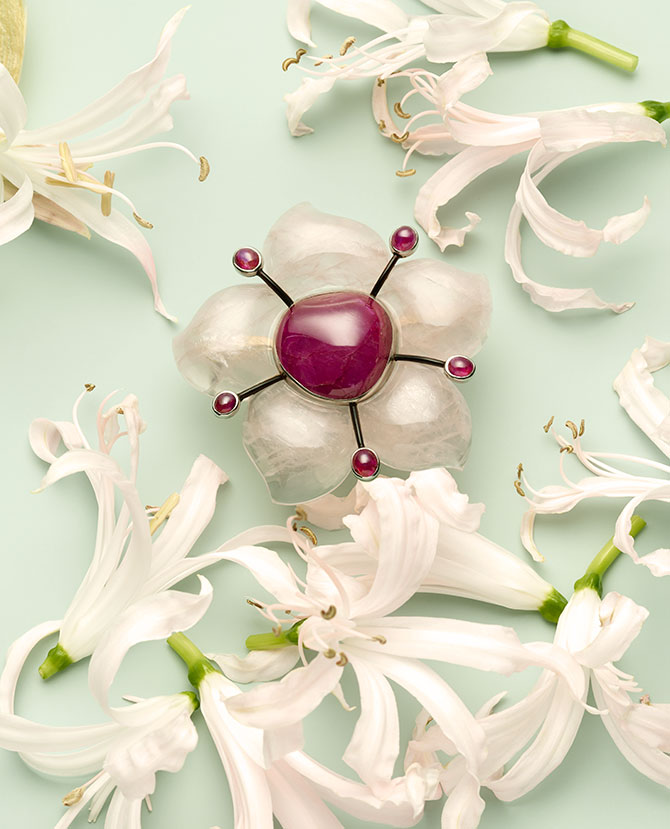 Ruby, rose quartz, and enamel Fleur gray and yellow gold brooch by Suzanne Belperron, circa 1936; price on request; Siegelson; 212-832-2666; siegelson.com
Ruby, rose quartz, and enamel Fleur gray and yellow gold brooch by Suzanne Belperron, circa 1936; price on request; Siegelson; 212-832-2666; siegelson.com
Sell Online
“We wouldn’t dream of not listing our vintage capsule on the website, as that’s often the first point of contact a client will have with our brand,” says Jennifer Gandia, co-owner of New York City–based Greenwich St. Jewelers.
For website design inspiration, check out Trumpet & Horn, Fox & Bond, Victor Barboné, and Erstwhile Jewelry, which nail it in terms of optics, user experience, and making vintage jewelry feel fresh and wearable.
Finally, enlist a professional photographer to shoot your collection. For product description pages, go with a clean, simple presentation (no models or additional styling) so clients can embrace every detail.
Entice, Engage, and Educate
That most vintage jewelry departs drastically from the norm makes it a natural fit for promoting on Instagram. Use this, and your other social media platforms, to herald new acquisitions (many sales happen through the direct message feature). “Find out what separates you from the rest of the herd,” Moross says. “We’re known for our lengthy storylike posts that educate our followers and get them interested in the historical value of each piece.”
Seth Berman, a partner at Provident Jewelry, a south Florida–based retailer with a thriving estate jewelry business, suggests treating your vintage collection as its own brand with its own marketing strategy (including print, online, and TV ads, signage, and email blasts)—much as you would for one of your store’s best-selling contemporary lines. “The buy/sell/trade trifecta is essential to our business, and we’re always communicating that,” he says. “It’s a huge draw for customers.”
Remember, customers are in it for the romance. “Stores that know how to market the romance of antique diamonds do really well with them,” says Eric Mor, president of Abe Mor Diamond & Estate Buyers in New York City. “When you tell someone, ‘This stone was cut in the 1850s and came out of one of two diamond mines operating in South Africa at the time,’ their eyes light up.”
And use the word vintage whenever applicable. “ ‘Estate’ makes most people think of funerals, and ‘pre-owned’ calls to mind a bag of old T-shirts dropped off at the Goodwill,” Stone says. “Vintage is something rare, something with a story, and there’s nothing millennials like better than something that has a story.”